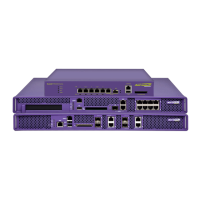Summit WM3000 Series Controller System Reference Guide 171
4 When using clustering and the Cluster GUI feature is enabled a drop-down menu will be available to
select which cluster members’ MUs are displayed. To view MUs from all cluster members, select All
from the drop-down menu. To view MUs from a specific cluster member, select that member’s IP
address from the drop-down menu.
5 To add a MAC address to MU association, click the Add button. For more information on adding an
association, see “MAC Naming of Mobile Units” on page 171.
6 To remove a MAC Name association select the item from the table and click the Delete button.
7 If changes have been made to the MU table, click the Apply button to save the changes to the
running config.
MAC Naming of Mobile Units
To configure Mobile Unit settings:
1 Select Network > Mobile Units from the main menu tree.
2 Click the Configuration tab and select Add.
3 Enter the MAC Address and MAC Name for the MU being added to the list:
4 Click OK to use the changes to the running configuration and close the dialog.
5 Click Cancel to close the dialog without committing updates to the running configuration.
Viewing MU Statistics
The Statistics screen displays read-only statistics for each MU. Use this information to assess if
configuration changes are required to improve network performance. If a more detailed set of MU
statistics is required, select a MU from the table and click the Details button.
The Summit WM3600 supports a maximum of 4096 MUs. The Summit WM3700 supports 8192 MUs.
MAC Name
The
MAC Name
is a user created name used to identify individual mobile
unit MAC Addresses with a user friendly name. To edit an existing entry,
double click the
MAC Name
and type in the new name.
MU MAC Address
Each MU has a unique Media Access Control (
MAC
) address through
which it is identified. This address is burned into the ROM of the MU.
MAC Name
The
MAC Name
is a user created name used to identify individual mobile
unit MAC Addresses with a user friendly name. The MAC name can not
contain the following special characters: ‘/’, ‘\’, ‘.’, ‘*’, ‘?’, ‘”’, ‘<‘, ‘>’, ‘|’.

